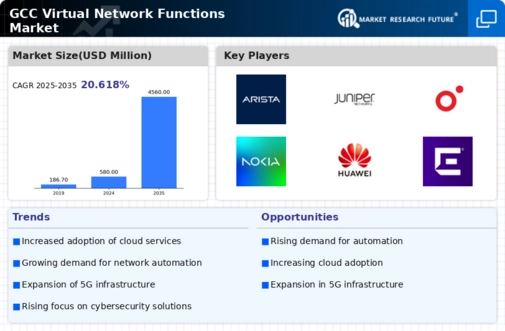Growing Focus on 5G Deployment
The ongoing deployment of 5G networks in the GCC is significantly influencing the virtual network-functions market. As telecommunications companies invest heavily in 5G infrastructure, there is a corresponding demand for virtualized network functions that can support the high-speed and low-latency requirements of 5G services. This trend is expected to drive innovation and investment in the virtual network-functions market, as service providers seek to leverage the capabilities of 5G technology. The market is anticipated to expand as organizations recognize the potential of virtual network functions to enhance their service offerings in a 5G-enabled environment.
Rising Demand for Network Flexibility
The virtual network-functions market is experiencing a notable surge in demand for enhanced network flexibility. Organizations in the GCC are increasingly seeking solutions that allow for rapid deployment and scalability of network services. This shift is driven by the need to adapt to changing business environments and customer requirements. According to recent data, the market is projected to grow at a CAGR of approximately 15% over the next five years. This growth indicates a strong inclination towards adopting virtualized solutions that can be easily modified to meet specific operational needs. As businesses strive for agility, the virtual network-functions market is positioned to play a crucial role in enabling this transformation.
Integration of Artificial Intelligence
The integration of artificial intelligence (AI) into the virtual network-functions market is emerging as a transformative driver. AI technologies are being utilized to enhance network management, automate processes, and improve decision-making capabilities. In the GCC, companies are increasingly adopting AI-driven solutions to optimize network performance and security. This trend is expected to contribute to a more efficient allocation of resources and improved service delivery. The virtual network-functions market is likely to benefit from this integration, as AI can facilitate predictive analytics and real-time monitoring, thereby enhancing overall operational efficiency.
Cost Efficiency and Resource Optimization
Cost efficiency remains a pivotal driver in the virtual network-functions market. Organizations in the GCC are increasingly recognizing the financial benefits associated with virtualized network solutions. By transitioning from traditional hardware-based systems to virtualized environments, companies can significantly reduce capital expenditures and operational costs. Reports suggest that businesses can save up to 30% on infrastructure costs by implementing virtual network functions. This financial incentive is compelling, particularly for small and medium-sized enterprises looking to optimize their resources. As a result, the virtual network-functions market is likely to witness sustained growth as organizations prioritize cost-effective solutions.
Increased Regulatory Compliance Requirements
The virtual network-functions market is also being shaped by heightened regulatory compliance requirements in the GCC. Organizations are facing increasing pressure to adhere to data protection and privacy regulations, which necessitate the implementation of robust network security measures. Virtual network functions can provide the necessary tools to ensure compliance with these regulations, thereby enhancing data security and integrity. As businesses strive to meet these compliance standards, the demand for virtual network-functions is likely to rise. This trend indicates a growing recognition of the importance of regulatory adherence in shaping the future of the virtual network-functions market.

















Leave a Comment